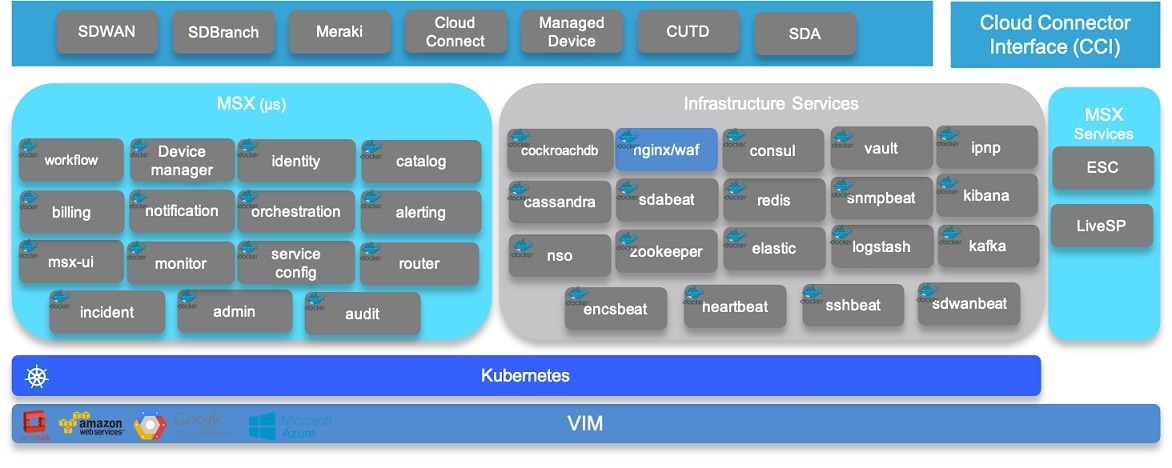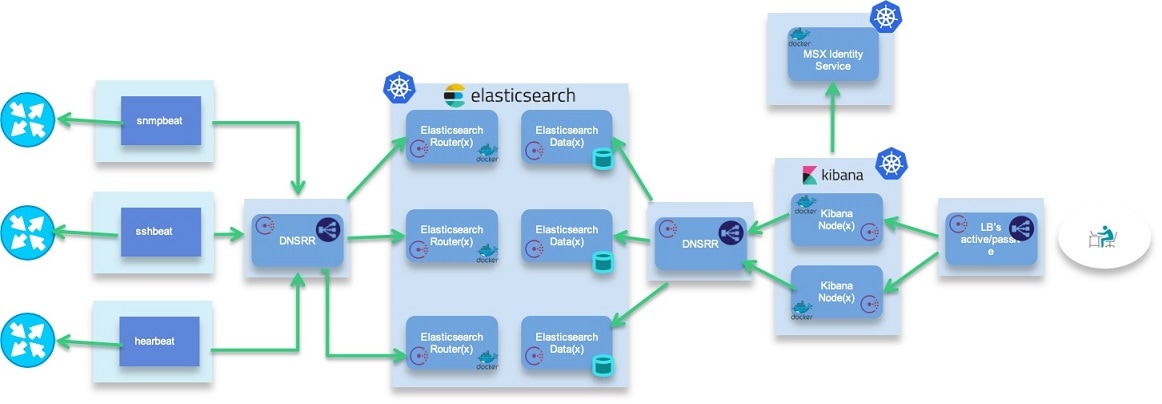Solution Overview
Cisco MSX is a service creation and delivery platform that enables fast deployment of cloud-based and on-premise networking services for both Enterprises and Service Providers customers. Small-to-Medium Businesses (SMBs) and Enterprises can deliver customizable network services using a subscription-based and pay-as-you-go model. Operators benefit from a solution which allows them to rapidly and profitably deliver service offerings to market. The service turn-up time is reduced from 4 to 6 weeks to a matter of days.
Cisco MSX also integrates with existing customer premise equipment, allowing operators to build upon and utilize the existing infrastructure. Cisco MSX provides a complete self-service user experience that allows operators and end-users to select, create, customize, and activate services on-demand in minutes from a simple, intuitive portal.
The Cisco MSX solution shifts the deployment of managed services away from the manual configuration of the latest network devices to the creation of an abstractef model representing the service definition. This approach allows the service intent of the user to be realized by using service models to automate the creation and customization of network services. Depending on the capabilities of the domain being configured these services are instantiated either through MSX embeddedCisco Network Services Orchestrator (NSO) instance or a domain specific controller.
Through the combination of the Cisco MSX platform and service packs, the Cisco MSX solution offers a complete platform that enables Service Providers and Enterprises to offer next-generation network services.
The following are some key highlights of the Cisco MSX solution:
-
Automated end-to-end, cloud-based, and on-premise services managed from public or private clouds.
-
Secure multi-tenant cloud managed platform, simplified orchestration, and tenant self-service.
-
Auto onboarding of devices with Zero Touch Provisioning.
-
Rapidly create new monetizable services, and modify existing services instantly from the cloud.
-
Perfect solution for distributed customers looking for lower cost and self-managed services.
-
Open, multi-vendor, services catalog.
-
Supports Cisco and third-party physical devices and Virtual Network Functions (VNFs).
-
Develop your own service or adapt existing services.
-
Can be integrated with existing OSS and BSS systems.
The chapter has the following section:
Cisco MSX Platform
Cisco MSX is a service creation platform, implementing the different functions that are required to instantiate and provision virtual and physical elements in order to construct end-to-end managed services for Service Provider and Enterprise customers. The Cisco MSX solution uses Software-Defined Networking (SDN), Network Functions Virtualization (NFV), Open APIs, and advanced orchestration capabilities to deliver a suite of business services from the cloud (public or private), over existing network infrastructure.
The Cisco MSX platform is comprised of layers,each of which abstract the layer below it and scaled horizontally. A layered abstraction approach, with well documented API contracts between the layers, allows for modularization, a key tenet of the MSX platform. The modularization allows for the separation of concerns, independent scaling, development velocity, and ultimately component replacement, if necessary.
Microservices
The Service Interface Function (SIF) and integrations are enabled as microservices that contain the logic to consume the functionality exposed by the platform. There is a standard set of microservices that expose the core platform functionality that is required to operate the platform.
Each use case can also provide one or more microservices for any use-case-specific functionality that needs to be enabled.
The following primary core microservices exist in Cisco MSX platform:
-
Identity Management (IDM)—Provides user management capabilities, tenant management (tenant and tenant group), manages identity providers, user roles, permissions, secrets, password policies, and so on. Upon login, fetches the user profile and stores it in the common cache so other microservices can use it. Also provides SAML 2.0 and OAuth 2.0 capabilities for Single Sign On (SSO), authentication, and authorization capabilities.
-
Catalog—Provides the capability to create services, service offers, price plans, define terms and conditions of a service, submit an order, and upgrade or downgrade a service.
-
Manage—Provides the service management capabilities, such as managing customer subscriptions and device data.
-
Monitor—Communicates with the service assurance components for device and service status and displays the statistics on the Portal.
-
Orchestration—Communicates with NSO to process the request to create or upgrade a service chain, add or delete a device, register device serial numbers, and advanced device configurations.
-
Notification—Cisco MSX provides support to trigger notifications when certain events occur. Both REST and email notifications are supported for all the events.
-
Administration—Manages global activities and settings. Activities include importing bulk device settings, obtaining component versions, scheduling tasks, managing provider contacts, and user interface themes.
-
Workflow—Provides the capability to manage and execute service-oriented workflows
-
Billing—Provides the capability to collect and expose billing related events.
-
Incident—Enables you to integrate the Cisco MSX platform with an incident tracking system specially ServiceNow. Using this API, you can create, update, cancel, close, and delete an incident using the access token.
-
Service Configuration—Manages configuration templates, track the assignment and application of those templates to a tenant.

Data Platform
The data platform interface is the mechanism by which the data platform component interacts with the other platform components and applications. The major function that is performed by the data platform component is the collection of data from the platform, service packs, controllers, and devices. The collection interface provides a platform component or application the ability to instruct the data platform which data to collect, the frequency with which to collect, and how to store and correlate the data. This is to enable other platform components or external systems to augment the collection that is enabled by provisioning. For example, the instantiation of a typical service chain programs the devices participating in the chain to send data (Syslog/SNMP) to the data platform.
There are several actions that must be supported by the data platform component, and thus exposed via the service interface. The actions include, but are not limited to:
-
Data Retrieval (Pull)
-
Configurable Collection
-
Data Subscription/Streaming (Triggers/Events)
The data platform component of the architecture is broken down into the following major sub-functions, as shown in the following illustration.

About this Content
This section provides information about related documentation of Cisco MSX and trademarks used in this content.
Related Documentation
You can access Cisco MSX 4.1 content at https://www.cisco.com/c/en/us/support/cloud-systems-management/managed-services-accelerator/series.html#~tab-documents.
The documents listed here are available for additional reference. To access API documentation on the Swagger GUI, log in to the MSX GUI and navigate to My Profile > Swagger API.
Cisco MSX SDK documentation is available at https://developer.cisco.com/site/msx/.
|
Document |
Description |
|---|---|
|
This documentation provides information about the new features in Cisco Managed Services Accelerator (MSX) 4.1. |
|
|
This documentation covers the post-install configuration information that is required to set up MSX. |
|
|
Cisco Managed Services Accelerator (MSX) 4.1 Platform and Service Pack Permissions Addendum |
This addendum covers all the permissions that are required to operate MSX and the service packs. |
|
This documentation includes details that are related to deploying, managing, configuring the Cisco MSX SD-WAN service pack, and troubleshooting service errors. |
|
|
Cisco Managed Services Accelerator (MSX) 4.1 SD-WAN and Meraki Out-of-the-Box Applications Addendum |
This document is an addendum to the Cisco MSX SD-WAN Service Pack content. It has details about the out-of-the-box applications of MSX 4.1 and the comparison of applications in MSX 3.10 with applications in MSX 4.1 based on possible application mapping. |
|
Cisco Managed Services Accelerator (MSX) 4.1 Enterprise Access |
This documentation includes details that are related to deploying, managing, configuring the Cisco MSX Enterprise Access service pack, and troubleshooting service errors. |
|
This documentation provides a comprehensive explanation of the design of the MSX solution that enables service providers to offer flexible and extensible services to their business customers. |
|
|
This documentation contains licenses and notices for Open Source software that is used in this product. |
Bias-free Doc Disclaimer
 Note |
The documentation set for this product strives to use bias-free language. For purposes of this documentation set, bias-free is defined as language that does not imply discrimination based on age, disability, gender, racial identity, ethnic identity, sexual orientation, socioeconomic status, and intersectionality. Exceptions may be present in the documentation due to language that is hardcoded in the user interfaces of the product software, language used based on RFP documentation, or language that is used by a referenced third-party product. |
Full Cisco Trademarks with Software License
THE SPECIFICATIONS AND INFORMATION REGARDING THE PRODUCTS IN THIS MANUAL ARE SUBJECT TO CHANGE WITHOUT NOTICE. ALL STATEMENTS, INFORMATION, AND RECOMMENDATIONS IN THIS MANUAL ARE BELIEVED TO BE ACCURATE BUT ARE PRESENTED WITHOUT WARRANTY OF ANY KIND, EXPRESS OR IMPLIED. USERS MUST TAKE FULL RESPONSIBILITY FOR THEIR APPLICATION OF ANY PRODUCTS.
THE SOFTWARE LICENSE AND LIMITED WARRANTY FOR THE ACCOMPANYING PRODUCT ARE SET FORTH IN THE INFORMATION PACKET THAT SHIPPED WITH THE PRODUCT AND ARE INCORPORATED HEREIN BY THIS REFERENCE. IF YOU ARE UNABLE TO LOCATE THE SOFTWARE LICENSE OR LIMITED WARRANTY, CONTACT YOUR CISCO REPRESENTATIVE FOR A COPY.
The Cisco implementation of TCP header compression is an adaptation of a program developed by the University of California, Berkeley (UCB) as part of UCB's public domain version of the UNIX operating system. All rights reserved. Copyright © 1981, Regents of the University of California.
NOTWITHSTANDING ANY OTHER WARRANTY HEREIN, ALL DOCUMENT FILES AND SOFTWARE OF THESE SUPPLIERS ARE PROVIDED “AS IS" WITH ALL FAULTS. CISCO AND THE ABOVE-NAMED SUPPLIERS DISCLAIM ALL WARRANTIES, EXPRESSED OR IMPLIED, INCLUDING, WITHOUT LIMITATION, THOSE OF MERCHANTABILITY, FITNESS FOR A PARTICULAR PURPOSE AND NONINFRINGEMENT OR ARISING FROM A COURSE OF DEALING, USAGE, OR TRADE PRACTICE.
IN NO EVENT SHALL CISCO OR ITS SUPPLIERS BE LIABLE FOR ANY INDIRECT, SPECIAL, CONSEQUENTIAL, OR INCIDENTAL DAMAGES, INCLUDING, WITHOUT LIMITATION, LOST PROFITS OR LOSS OR DAMAGE TO DATA ARISING OUT OF THE USE OR INABILITY TO USE THIS MANUAL, EVEN IF CISCO OR ITS SUPPLIERS HAVE BEEN ADVISED OF THE POSSIBILITY OF SUCH DAMAGES.
Any Internet Protocol (IP) addresses and phone numbers used in this document are not intended to be actual addresses and phone numbers. Any examples, command display output, network topology diagrams, and other figures included in the document are shown for illustrative purposes only. Any use of actual IP addresses or phone numbers in illustrative content is unintentional and coincidental.
All printed copies and duplicate soft copies of this document are considered uncontrolled. See the current online version for the latest version.
Cisco has more than 200 offices worldwide. Addresses and phone numbers are listed on the Cisco website at www.cisco.com/go/offices.
Cisco and the Cisco logo are trademarks or registered trademarks of Cisco and/or its affiliates in the U.S. and other countries. To view a list of Cisco trademarks, go to this URL: https://www.cisco.com/c/en/us/about/legal/trademarks.html. Third-party trademarks mentioned are the property of their respective owners. The use of the word partner does not imply a partnership relationship between Cisco and any other company. (1721R)
 Feedback
Feedback